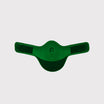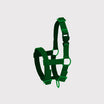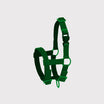An ear infection is an inflammation of the outer ear canal. Inflammation of the skin causes the ear canal to become narrower. This makes it harder for earwax to drain and can make the infection worse.
Lop-eared breeds are more prone to this than prick-eared breeds. This is because little air can get to the hanging ears. The inside of the ears becomes warm and moist faster and thus offers an ideal breeding ground for bacteria, fungi and mites. The breed is also prone to ear infections. Examples of dog breeds that suffer more often are the Cocker Spaniel, Golden Retriever and German Shepherd.
What are the causes of an ear infection?
Bacteria, yeasts and fungi find an ideal environment in which to multiply in the ear. When the dog scratches its ear, it creates wounds in which bacteria, yeast and fungi can continue to multiply.
Ear mites can cause ear infections, it is a highly contagious parasite. The ear mites usually affect both ears, recognizable by the dark earwax.
A foreign object in the ear can also cause an infection. This object irritates the eardrum and can even pierce it. In summer it often happens that a spike of grass lands in the ear and then irritates the hole.
Skin problems like allergies can cause inflammation that can lead to hypersensitivity.
In addition, a polyp can be a cause of an ear infection. A polyp is a small tumor in the animal's ear canal. However, this cause is more common in cats than in dogs.
What are the symptoms?
-
Shake your head
-
Head tilt (usually associated with an otitis media)
-
Itching and scratching in the ear
-
thickening of the ear canal
-
Painful when ear is touched
-
deafness or hearing impairment
-
The inside of the ear is red
-
Stinking odor from ears
-
Brown/black earwax
-
Lots of wax
When should I take this to the vet?
An ear infection is very painful for the dog, and the eardrum can also be permanently damaged. The earlier you get there, the lower the risk of serious hearing damage. During the treatment, the dog must visit the veterinarian regularly
How is the treatment?
Treatment depends on the cause. You can opt for treatment using ointments, which come in a variety of forms. The ointments are used to treat redness, bacteria, yeast and mites. If mites or fleas are the cause, an eyedropper can help treat it. Painkillers can also be chosen, these are mainly used if the dog is in enormous pain as a result of the ear infection.
If the earwax needs to be removed, you can use ear cleaners. These cleaners are mainly used when large amounts of earwax have to be removed. If there is a lot of earwax, rinsing can often be a solution. Rinsing allows ointments to develop their effect.
Cutting the hair out of the ear often gives the ear more air and reduces the risk of infection.
What is the prognosis of an ear infection?
The prognosis depends on the cause, but it is also important to know whether the eardrum is damaged or not. Ear infections are treatable, so the outlook is good.
This text was translated by a translation machine
 Horse Pharmacy
Horse Pharmacy Rugs
Rugs Care
Care Saddle and Attachments
Saddle and Attachments Leg Protection
Leg Protection Bridles
Bridles Feed
Feed Fly Masks
Fly Masks Saddle Pads
Saddle Pads Headcollars and Ropes
Headcollars and Ropes Bits
Bits Other Disciplines
Other Disciplines Reins and Auxiliary Reins
Reins and Auxiliary Reins Clipping
Clipping Western
Western Eventing
Eventing Foals
Foals Reflection
Reflection Therapy Products
Therapy Products Boots and Shoes
Boots and Shoes Breeches and Belts
Breeches and Belts Tops
Tops Safety
Safety Competition
Competition Heated Clothing
Heated Clothing Gloves
Gloves Socks
Socks Spurs and Attachments
Spurs and Attachments Technology
Technology Whips
Whips Gifts
Gifts Casual Wear
Casual Wear Underwear
Underwear Rider Pharmacy
Rider Pharmacy Bags
Bags Books
Books Laundry supplies
Laundry supplies Jewelry
Jewelry Feed and Waterbowls
Feed and Waterbowls Equipment
Equipment Tack Room
Tack Room Pest Control
Pest Control Arena
Arena Horse Toys
Horse Toys Wheelbarrows
Wheelbarrows Yard
Yard Surveillance
Surveillance Disinfect
Disinfect Washing Area
Washing Area Lighting
Lighting Horse Pasture
Horse Pasture Current Conductors
Current Conductors Pole
Pole Insulators
Insulators Energisers
Energisers Gate Handles
Gate Handles Batteries and Accumulator
Batteries and Accumulator Nets
Nets Grounding
Grounding Tools
Tools Fencing Security
Fencing Security Wolf Defense
Wolf Defense Fencing Sets
Fencing Sets Fence locks
Fence locks Dogs
Dogs Cats
Cats Rodents
Rodents Dogs Pharmacy
Dogs Pharmacy Cats Pharmacy
Cats Pharmacy Rodents Pharmacy
Rodents Pharmacy Cattle Pharmacy
Cattle Pharmacy Poultry Pharmacy
Poultry Pharmacy Veterinary Supplies
Veterinary Supplies Cattle
Cattle Sheep and Goats
Sheep and Goats Poultry
Poultry Heat Lamps
Heat Lamps Calves
Calves Marking
Marking Halters
Halters